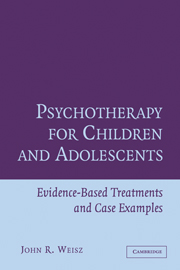Book contents
- Frontmatter
- Contents
- Preface
- SECTION A GENERAL INTRODUCTION
- SECTION B TREATMENTS FOR FEARS AND ANXIETY
- SECTION C TREATMENTS FOR DEPRESSION
- SECTION D TREATMENTS FOR ATTENTION DEFICIT/HYPERACTIVITY DISORDER
- SECTION E TREATMENTS FOR CONDUCT PROBLEMS AND CONDUCT DISORDER
- Introduction to Section E: The Case of Sal and Treatments for Conduct Problems and Conduct Disorder
- 8 Treating Conduct Problems by Teaching Anger Control
- 9 Behavioral Parent Training and Family Treatment for Conduct Problems
- 10 Parent-Child Interaction Treatments for Child Noncompliance
- 11 Parent Training through Video Modeling and Structured Group Discussion
- 12 Using Problem-Solving Skills Training and Parent Management Training for Children with Conduct Disorder
- 13 Multisystemic Therapy for Antisocial and Delinquent Youth
- SECTION F CONCLUSION
- References
- Author Index
- Subject Index
13 - Multisystemic Therapy for Antisocial and Delinquent Youth
Published online by Cambridge University Press: 06 July 2010
- Frontmatter
- Contents
- Preface
- SECTION A GENERAL INTRODUCTION
- SECTION B TREATMENTS FOR FEARS AND ANXIETY
- SECTION C TREATMENTS FOR DEPRESSION
- SECTION D TREATMENTS FOR ATTENTION DEFICIT/HYPERACTIVITY DISORDER
- SECTION E TREATMENTS FOR CONDUCT PROBLEMS AND CONDUCT DISORDER
- Introduction to Section E: The Case of Sal and Treatments for Conduct Problems and Conduct Disorder
- 8 Treating Conduct Problems by Teaching Anger Control
- 9 Behavioral Parent Training and Family Treatment for Conduct Problems
- 10 Parent-Child Interaction Treatments for Child Noncompliance
- 11 Parent Training through Video Modeling and Structured Group Discussion
- 12 Using Problem-Solving Skills Training and Parent Management Training for Children with Conduct Disorder
- 13 Multisystemic Therapy for Antisocial and Delinquent Youth
- SECTION F CONCLUSION
- References
- Author Index
- Subject Index
Summary
Like all of us, troubled children and teens are embedded within complex social systems. Each youngster's behavior reflects his or her own attributes interacting with characteristics of the family, peer group, neighborhood, school, and so forth. With antisocial and delinquent youths, there are often problems at (and between) multiple levels of the social system. Yet most of the tested treatments for conduct problems focus on only one or two of the layers. Anger management programs, for instance, focus treatment mainly on the individual youths who have problems in self-control (see Chapter 8). Other programs emphasize parent training and the parent-child relationship (see Chapters 9, 10, and 11). Still other programs focus on the family system (see Chapter 9) or pair youth training with parent training (see Chapter 12). In contrast to these approaches, multisystemic therapy (MST), to which we now turn, is an attempt to reach out and touch most of the major social systems that envelop antisocial and delinquent youth.
Included in the purview of MST are such social systems as the youth's family, family support network, school, neighborhood, peer group, and in many cases, probation officer and juvenile justice system. The MST therapist has a complex job, one that may not include much time in a clinic office and may not entail waiting for troubled clients to come in seeking help. Instead, much of the therapist's work day is spent in the settings where the young clients live their lives, and the people with whom the MST therapist talks include many of those who touch the young clients’ lives.
- Type
- Chapter
- Information
- Psychotherapy for Children and AdolescentsEvidence-Based Treatments and Case Examples, pp. 414 - 444Publisher: Cambridge University PressPrint publication year: 2004



